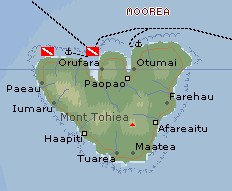
Click the map for a
Society Isles overview
|
Pacific Landfalls Fr. Polynesia Pages Related Pages |
Moorea
 Click the map for a Society Isles overview |
Language: Tahitian, French
Population: 12,000 as of 2000
Money: French Polynesian Franc
Landscape: Lush greenery covering craggy peaks.
Visited: Four times: February 11-15, 18-21, 23-28, and March 4-7, 2004.
Also: Read about diving in Moorea.
History: Moorea, meaning "offshoot" or "yellow lizard," depending on who you ask, has also been known through history as Aimeho (though Captain Cook spelled it Eimeo) and Fe'e (octopus). The "octopus" idea came from the ridges that today divide the island into eight segments.
 Opunohu Bay, much the same as seen by Captain Cook centuries ago |
Captain Cook, the first main European influence of much of Polynesia, spent only a week in Moorea. Surprisingly, he anchored in Opunohu Bay and didn't even visit the one for which he is the namesake! This visit probably tainted the natives' view of Europeans, as he destroyed many canoes and houses when the islanders refused to return a stolen goat. At the time, Polynesians didn't have the western concept of 'ownership' (which would be an interesting way to live...).
Pomare I of Tahiti conquered Moorea in 1792, with a little
assistance from the Bounty mutineers - in the form of weapons. Sixteen years
later, Pomare II began his exile on the island after he failed to bring all of
Tahiti under his command. He was joined on Moorea by a party of English
missionaries who, several years later, achieved a fifteen-year goal of theirs: Pomare II
had finally been converted. It won Moorea a special place in the
history of Christianity. In 1815, the high priest of Oro accepted Protestantism
openly and publicly, emphasizing his statement by burning the "heathen idols" at
Papetoai. The whole population followed his example rather quickly.
Pomare II eventually succeeded in re-conquering Tahiti. It was
achieved with the assistance of the missionaries in 1815 - the true reason for
his acceptance to being "converted." Moorea soon became just a backdrop for
Tahiti, although a beautiful, plantation-covered one.
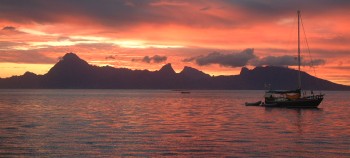 Moorea at sunset, seen from western Tahiti |
(Jon) Moorea was one of my favorites among the Society
Islands, along with Huahine and
Bora-Bora. The grandeur of the scenery,
especially the 2 main bays, is awe-inspiring. It's populated just enough
that we could get food, water and scuba fills easily, and recreation possibilities
abounded. With Karen
& Jon we rented bicycles and enjoyed a delightful 37 mile ride around the
island. We visited spectacular viewpoints, saw some interesting
archaeological sites, and took some delightful hikes
through the interior.
The most memorable events, however, were underwater.
Moorea abounds in both scuba and
snorkeling sites, with some spectacular scenery.
Vince,
Karen & Jon were very into scuba
diving, so we often went twice a day, diving several sites both
inside and
outside the
Moorea reef. We even found dive shops willing to fill our bottles for $5, about
half the going rate in Tahiti.
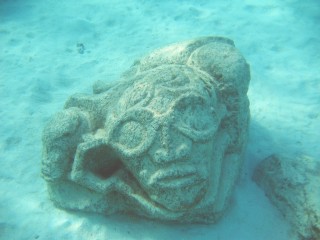 We found 12 stone Tikis underwater in Moorea |
Bill & Mary
aren't divers, but they love to go snorkeling. With them we found sunken
carved Tiki stones and nice coral gardens to snorkel in. Stone Tikis are
usually only made in the Marquesas - the Society
Islanders usually carve their Tikis out of wood. These were apparently
carved and put in the ocean to protest against the missionaries throwing the old
wooden Tikis into the ocean years earlier.
We also found
where the stingrays like to congregate, just as they do in Grand Cayman.
These rays behave almost like puppy dogs, nuzzling up to be fed. They can
be quite insistent but they're not dangerous unless you step right on one, so
shuffling feet is the best movement technique.
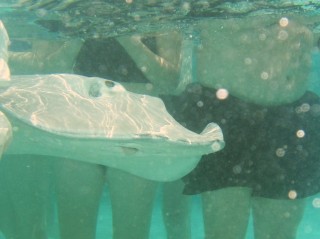 A Tahitian stingray glides past tourists, looking for a hand-out of squid |
They're about 3 feet (1m) across, with eyes are on top of their bodies and mouths on the bottom, which gets interesting. They come towards the fish in your hand, and turn on their "vacuum cleaner" mouths as they get close. Since they they can't see, they sometimes miss your hand. If they get any other part of you, their vacuum is strong enough to give you a "hicky". Feeding and stroking them is fun once you get used to it, but it can be a little overwhelming until then, especially as there was quite a current running.
(Amanda) Moorea I mainly remember as our base for a heck of a
lot of diving. I hardly went ashore at all, except when Bill & Mary were
onboard and Mom, Dad, and I took a LONG hike down from the viewpoint that they had
driven us up to. But it was really a good break from big-city Papeete and all
the marinas and the big, full anchorage. Most of the time, we were the only boat
in the anchorage - except for the constant tourist/dive boats and pirogues that
went by every day.
The diving was okay, though you had to choose between deep,
murky, current, swell, or sharks. Or shark-suckers, depending. I only did one
dive, and chose the murky but no current, surge, or sharks. I go through air
fast enough as is, I don't need to start hyperventilating, thank you!
 The Opunohu Valley from the ridge above it |
(Sue) Moorea was a lovely surprise after the hustle and bustle of Tahiti. Walking the roads between big hotel resorts we passed small homes with colorful gardens festooned with flowers and fruit trees. Public transport is less frequent then on Tahiti, but still allowed us to cover half the island in a few minutes to begin a cross-island hike (8 hours!) with our friends Karen & Jon. Moorea underwater was superb, and the scenery, when we poked our heads up, was sublime. Although many cruising boats speak of anchoring deep inside both Cook's and Opunohu Bays, I loved being anchored in 10 to 15 feet of aqua water over sand banks at the mouths of the bays. This gave us great views of the shoreline and majestic volcanic hills.
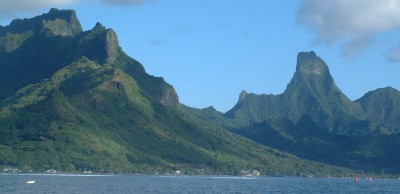 Cook's Bay on the north coast of Moorea |
(Chris) After Tahiti, Moorea seemed beautifully
empty. No cities, even relatively small ones like Papeete. Lots of trees, especially around
the water, and very little development. Of course, I didn't see much of the island,
just the area around the anchorage. Moorea does have a
small airport, for example. However, I got an overall impression of a mostly untouched island.
Most of my
memories of Moorea have to do with
snorkeling or diving. Tahiti had wrecks, but Moorea had interesting reef,
which is in many ways better. There was a lot more underwater exploring in
Moorea. Moorea also had sharks, stingrays, eels, and other large and rarely seen
animals.
Moorea Diving | Marquesas Newsletters | Tuamotus Newsletters | FP Flora & Fauna
Top Level: Home | Destinations | Cruising Info | Underwater | Boat Guests | Ocelot | Sue | Jon | Amanda | Chris | Site Map | Make a Comment
|
If our information is useful, you can help by making a donation |
Copyright © 2000‑ Contact: Jon and Sue Hacking -- HackingFamily.com, svOcelot.com. All rights reserved.